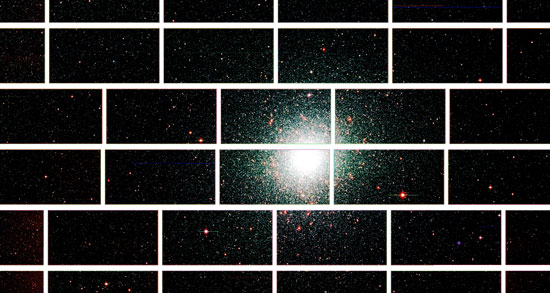| Sep 20, 2012 |
Dark energy camera to probe universe?s biggest mysteries
|
|
(Nanowerk News) Eight billion years ago, rays of light from distant galaxies began their long journey to Earth. On Sept. 12, that ancient starlight found its way to a mountaintop in Chile, where the newly-constructed Dark Energy Camera – the most powerful sky-mapping machine ever created – captured and recorded it for the first time.
|
|
That light may hold within it the answer to one of the biggest mysteries in physics: why the expansion of the universe is speeding up.
|
 |
| Zoomed-in image from the Dark Energy Camera of the center of the globular star cluster 47 Tucanae, which lies about 17,000 light years from Earth. (Image: Dark Energy Survey Collaboration)
|
|
Scientists on the Dark Energy Survey collaboration, including representatives from the U.S. Department of Energy’s (DOE) Argonne National Laboratory, announced this week that the Dark Energy Camera has achieved “first light.” The first pictures of the southern sky were taken by the 570-megapixel camera, the product of eight years of planning and construction, on Sept. 12.
|
|
“The achievement of first light through the Dark Energy Camera begins a significant new era in our exploration of the cosmic frontier,” said James Siegrist, DOE Associate Director of Science for High Energy Physics. “The results of this survey will bring us closer to understanding the mystery of dark energy, and what it means for the universe.”
|
|
The Dark Energy Camera was constructed at DOE’s Fermi National Accelerator Laboratory in Batavia, Illinois, and mounted on the Victor M. Blanco telescope at the National Science Foundation’s Cerro Tololo Inter-American Observatory (CTIO) in Chile.
|
|
With this device, roughly the size of a phone booth, astronomers and physicists will probe the mystery of dark energy, which gives rise to the force they believe is causing the universe to expand faster and faster.
|
|
“With all of our amazing scientific progress in the last century, we still only understand the four percent of the universe that is made of normal matter. The Dark Energy Survey will help us understand the other 96 percent, which we believe is made of dark matter and dark energy,” said Steve Kuhlmann, leader of the Dark Energy Survey group at Argonne.
|
|
The Dark Energy Camera is the most powerful survey instrument of its kind, able to see light from more than 100,000,000 galaxies up to 8 billion light years away in each snapshot. The camera’s array of 62 charged-coupled devices has an unprecedented sensitivity to very red light.
|
|
Many of the camera’s critical systems, such as the shutter, cooling, vacuum and alarms, are controlled with Argonne-designed technology. Along with the Blanco telescope’s large light-gathering mirror (which spans 13 feet across), the camera will allow scientists from around the world to pursue investigations ranging from studies of asteroids in our own solar system to the understanding of the origins – and the fate – of the universe.
|
|
Scientists in the Dark Energy Survey collaboration will use the new camera to carry out the largest galaxy survey ever undertaken, and will use that data to carry out four probes of dark energy, studying galaxy clusters, supernovae, the large-scale clumping of galaxies and weak gravitational lensing. This will be the first time all four of these methods will be possible in a single experiment.
|
|
The Dark Energy Survey is expected to begin in December, after the camera is fully tested, and will take advantage of the excellent atmospheric conditions in the Chilean Andes to deliver pictures with the sharpest resolution seen in such a wide-field astronomy survey.
|
|
Over five years, the survey will create detailed color images of one-eighth of the sky, or 5,000 square degrees, to discover and measure 300 million galaxies, 100,000 galaxy clusters and 4,000 supernovae.
|

